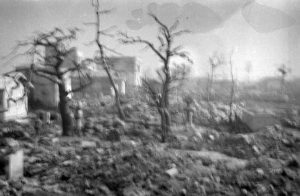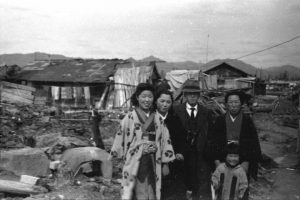Documenting Hiroshima of 1946: In January, shacks on banks of Kyobashi River
Jan. 4, 2025
by Kyosuke Mizukawa, Senior Staff Writer
In January 1946, shacks began to appear gradually on the incinerated ruins on the banks of Kyobashi River near Hiroshima Station in Hiroshima City. Morikichi Yasuda, who loved photography and died in 1984 at the age of 69, took photographs with his camera in Dote-machi (in the city’s present-day Minami Ward), an area that spread out around the east end of Yanagi Bridge, which had burned down at the time of the bombing. Judging from the clothing of citizens standing with their backs to the shacks and other evidence, the photos are thought to have been taken around New Year’s.
Morikichi’s family ran a long-established business by the name of Yasuda Shichibei Shoten, located in the Kyobashi-cho district (in Hiroshima’s present-day Minami Ward), close to Dote-machi. The business was a Japanese <em>sakeem> brewery that had been in operation since Japan’s Edo period (1603–1868) and produced the <em>sakeem> brand Sono no Shiragiku. The business also produced soy sauce. Morikichi’s older brother, Nakazo, the manager of the business who died in 1986 at the age of 73, wrote in a personal account about how the entire area had burned to the ground.
When the U.S. military dropped the atomic bomb on August 6, 1945, Nakazo was having breakfast at home next to the shop, around 1.6 kilometers from the hypocenter. He became trapped under the collapsed walls of the house but was rescued by his mother and older sister, who pulled him out from underneath.
Serving as head of a branch of a civil defense unit, Nakazo headed to a unit station nearby but found that it had collapsed. A vehicle equipped with a fire pump was crushed under the debris of the building and could not be used. The fires, which started out small in size at first, became full-fledged blazes everywhere, raging throughout the city. According to his personal account, “It was a situation where we could do nothing but let the fires burn.” He and other members of the unit spread out straw mats behind the station, hung mosquito netting on poles, and continued to assist the wounded and injured while stationing themselves there.
Morikichi had experienced the atomic bombing while in the area of Koi-cho (in Hiroshima’s present-day Nishi Ward). At the end of the year, accompanied by Nakazo, Morikichi had walked through the area near the hypocenter, taking photos of the collapsed <em>toriiem> gate of Hiroshima Gokoku Shrine and other spots. He also pointed his camera at the completely transformed garden at the site of his burned-down family home.
Unable to recover and resume its <em>sakeem> brewing business, Yasuda Shichibei Shoten ultimately closed down. Nakazo’s oldest son, Kunio, 77, a resident of Hiroshima’s Higashi Ward, said, “My father rarely talked about the atomic bombing. I think he didn’t want to remember.”
(Originally published on January 4, 2025)
In January 1946, shacks began to appear gradually on the incinerated ruins on the banks of Kyobashi River near Hiroshima Station in Hiroshima City. Morikichi Yasuda, who loved photography and died in 1984 at the age of 69, took photographs with his camera in Dote-machi (in the city’s present-day Minami Ward), an area that spread out around the east end of Yanagi Bridge, which had burned down at the time of the bombing. Judging from the clothing of citizens standing with their backs to the shacks and other evidence, the photos are thought to have been taken around New Year’s.
Morikichi’s family ran a long-established business by the name of Yasuda Shichibei Shoten, located in the Kyobashi-cho district (in Hiroshima’s present-day Minami Ward), close to Dote-machi. The business was a Japanese <em>sakeem> brewery that had been in operation since Japan’s Edo period (1603–1868) and produced the <em>sakeem> brand Sono no Shiragiku. The business also produced soy sauce. Morikichi’s older brother, Nakazo, the manager of the business who died in 1986 at the age of 73, wrote in a personal account about how the entire area had burned to the ground.
When the U.S. military dropped the atomic bomb on August 6, 1945, Nakazo was having breakfast at home next to the shop, around 1.6 kilometers from the hypocenter. He became trapped under the collapsed walls of the house but was rescued by his mother and older sister, who pulled him out from underneath.
Serving as head of a branch of a civil defense unit, Nakazo headed to a unit station nearby but found that it had collapsed. A vehicle equipped with a fire pump was crushed under the debris of the building and could not be used. The fires, which started out small in size at first, became full-fledged blazes everywhere, raging throughout the city. According to his personal account, “It was a situation where we could do nothing but let the fires burn.” He and other members of the unit spread out straw mats behind the station, hung mosquito netting on poles, and continued to assist the wounded and injured while stationing themselves there.
Morikichi had experienced the atomic bombing while in the area of Koi-cho (in Hiroshima’s present-day Nishi Ward). At the end of the year, accompanied by Nakazo, Morikichi had walked through the area near the hypocenter, taking photos of the collapsed <em>toriiem> gate of Hiroshima Gokoku Shrine and other spots. He also pointed his camera at the completely transformed garden at the site of his burned-down family home.
Unable to recover and resume its <em>sakeem> brewing business, Yasuda Shichibei Shoten ultimately closed down. Nakazo’s oldest son, Kunio, 77, a resident of Hiroshima’s Higashi Ward, said, “My father rarely talked about the atomic bombing. I think he didn’t want to remember.”
(Originally published on January 4, 2025)









